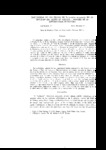Sinecología de las selvas de Terminalia amazonia en la vertiente del Golfo de México : análisis de la metodología de estudio

View/
Date
1968Author
Sarukán Kermez, José
Hernández Xolocotzi, Efraím
Metadata
Show full item recordAbstract
La metodología utilizada en los estudios sinecológicos efectuados por la Comisión para el Estudio Ecológico de las Dioscóreas, Instituto Nacional de Investigaciones Forestales, SAG, está basada en la definición de Tipos de Vegetación y de las asociaciones tanto primarias como secundarias existentes. En conjunto, Tipos y Asociaciones, permiten diferenciar unidades ecológicas para cada una de las cuales se determina la composición florística, la abundancia, la frecuencia, el área basal (diámetro a la altura del pecho) y cobertura de todos los elementos arbóreos de 3.3 cm o más de diámetro a la altura del pecho, en cuadros de muestreo que varían de 500 a 2,000 m cuadrados. En este estudio se analizan en forma crítica los resultados obtenidos por este método en las Selvas Altas Perennifolias de Terminalia amazonia de la Planicie Costera del Golfo de México y se indican las limitantes del método y las modificaciones que conviene adaptar para elevar estos estudios de la fase netamente descriptiva a la fase susceptible de análisis estadístico. ABSTRACT: The methodology adapted for the synecological studies conducted bye the Commission for the Ecological Study of Dioscoreas, National Institute of Forestry Research in Mexico, is based on the identification of Vegetative Types and the existing primary and secondary plant associations. These two concepts, Vegetative Types and Associations, permit the differentiation of ecological units of study. For each of these units, the following data were obtained: floristic composition, abundance, frequency, basal area (diameter breast high) and coverage of all the woody elements 3.3 cm diameter breast high or more. The cuadrants sampled varied from 500 to 2,000 m2. This study is concerned with a critical analysis of the results obtained by this method in the High Evergreen Sylvas (High Rain Fores) of Terminalia amazonia in the Coastal Plains of the Gulf of Mexico. Limitations of the method are indicated and modifications suggested to change theses studies from a purely descriptive phase to one in which statistical analysis may permit a better understanding of the phenomena.
Collections
- Agrociencia [55]
